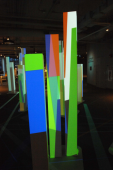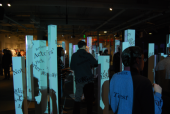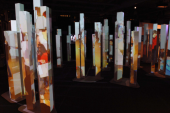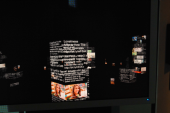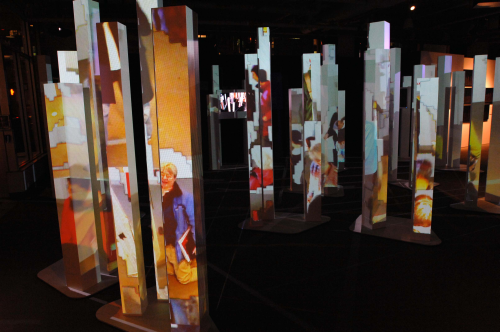
Metropath(ologies)
Metropath(ologies) is an immersive installation about living in a world overflowing with information and under non-stop surveillance. Visitors to the exhibit are not simply audience - their voices, faces, and data about them are incorporated part of the evolving artwork. The tone of the installation shifts from celebratory to sinister, deliberately ambiguous about the desirability of communicative abundance and person/data symbiosis.
Metropath(ologies) was created by Judith Donath, Yannick Assogba, Alex Dragulescu, and Aaron Zinman (the Sociable Media Group).
The installation evokes a metaphorical city of information. Visitors walk among 36 columns onto which text and images are projected, accompanied by an evolving soundtrack of city sounds and spoken data. Over the course of 9 minutes, the audio and projections move through states that range from abstract to literal, from serene to foreboding. Set among the columns are 3 stations that further explore the relationship between the datascape and its inhabitants.
The sound and images include live and recorded material ranging from global news reports to personal updates and private information. Visitors to the exhibit also find themselves incorporated into the it: their images are captured by surveillance cameras and then displayed on the columns and in the growing population of Cityscape figures, their names are entered into a database which mines the web for stories about them, their overheard voices are recorded and played back by the soundtrack, and as they walk among the columns they become a surface onto which this imagery is projected. Both congenial and sinister, Metropath(ologies) is a participatory space in which the visitors -- their names, faces, voices and data -- are truly a part.
The Metropath(ologies) progression
Over the course of 9 1/2 minutes, the audio and projections cycle through a 4-part sequence. The imagery for each movement is computer-generated and evolves as the underlying newsfeeds and databases change. The sound mixes music and samples with live synthesized speech generated from current news stories and personal data about the visitors.
Movement 1: Physical experience (3 min.)
This movement evokes everyday being. The images are abstract color blocks: sensation without words. The audio is a realistic soundscape, a collage of sampled sounds of water, traffic and crowds of people.
Movement 2: Information flood (3 min)
The second movement is about the accelerating flood of information we live with, and our attempts to manage the deluge by reading increasingly reduced and digested versions of things - tweets, headlines, keywords.
The projections feature current New York Times headlines, updated every hour. The audio, generated by processing news feeds (political, international and science from the Times and entertainment from People magazine ) and reading the result through a text-to-speech synthesizer, is backed by a darker, pulsating rhythm section. Each source plays through a different speaker with a different voice, so visitors walking through the exhibit move from story to story. At the beginning of the movement, longer passages from the texts are read verbatim and as it progresses, the material is increasingly filtered and compressed; the audio becomes increasingly abstract, moving from a human's phrases to a computer's analytic output.
Movement 3: Data citizens (3 min)
The third movement depicts city's inhabitants as rich sources of information - and illustrates their inability to control the data that flows from them.
The projections feature photographs of the visitors taken surreptitiously as they walked through the installation. The audio is much darker in both timbre and content; here the speech synthesizer reads out personal information about visitors to the exhibit, including their names, addresses and phone numbers. This data is obtained by searching online white-pages for the names visitors entered into the Personas terminal. As the movement progresses the audio is processed to become increasingly fragmented and distorted, introducing the theme of data corruption and errors.
Movement 4: Renewal
The sequence of increasing tense movements is followed by a short (30 seconds) contemplative period of complete silence. The projections are images of the visitors overlaid with headlines, but so greatly enlarged that they become abstract patterns.
Surveilling the audience
The installation has several ways of observing the visitors and incorporating them into the exhibit:
1. Visual surveillance: An unobtrusive camera in the installation photographs visitors. When people cross the area of the camera's focus an ultrasonic range-finder detects them and triggers the camera to take an image. Computer vision technology is used to separate the visitors' silhouettes from the background. The resulting images become part of the visuals of both the projections and the Cityscape station.
2. Audio surveillance: The sound of people talking in the installation is recorded during the 30 seconds of silence (4th movement) in the audio. This is incorporated into the soundscape.
3. Data surveillance: Visitors' names are collected when they enter them to have their data portrait made by the Personas station. The system uses this data to look up information about the visitors and incorporates their home address, etc. into the soundscape.
The stations: Data-Ghosts, Cityscape, and Personas
Among Metropath(ologies)' columns are three stations: Data-Ghosts, Cityscape, and Personas.
Data-Ghosts
In Data-Ghosts, digital identities and physical selves, ordinarily invisible in each other's world, co-exist within the Metropath(ologies) cityscape.
Data Ghosts shows a typical surveillance camera image: visitors see themselves within the installation, live on screen. Yet there is another presence in the scene - a ghostly figure, emitting a stream of words, moving among the columns.
The ghost's words derive from a randomly chosen Twitter account; each such account performs a unique motion sequence and then a new ghost appears. The ghosts are computationally rendered with the real-time camera scene so that they can move in and out among the columns, co-existing with the exhibit's visitors.
Cityscape
Cityscape depicts a synthetic city of information, its towers made of personal data and its inhabitants are photographic records of the installation's real visitors. Both the city and its population grow throughout the duration of the installation.
Cityscape's three-dimensional towers are visualizations of personal data drawn from social web applications such as Flickr, Twitter, Delicious, etc. Each tower represents one individual's data-feed over the last four weeks, with each level representing a single day's postings. New users are added each hour.
Photographs of visitors to Metropath(ologies), taken by the surveillance camera, populate the Cityscape street. They are randomly placed and updated every minute. The population of Cityscape grows throughout the duration of the installation.
Personas
Personas invites visitors to enter their name in order to see "how the Internet sees you". Upon receiving a name, Personas searches the web for information and attempts to characterize the person - to fit them to a predetermined set of categories algorithmically created from a massive corpus of data. The multiple stages of the computer's analysis is visualized, resulting in the presentation of a seemingly authoritative personal profile. Here, we see the computer's uncanny insights and its inadvertent errors, such as the mischaracterizations caused by the inability to separate data from multiple owners of the same name.
The names that are entered in the Persona's screen are also picked up by the audio generator, which searches a white-pages database for phone number and addresses. These are later played back within of the third, most sinister audio movement
exhibitions
Metropathologies was exhibited at the MIT Museum from February thru August of 2009. It was also in the show Virtual Identities at the Palazzo Strozzi, May-July 2011.
press
Review by Megan Driscoll, in Big,
Red and Shiny
Review by David Tames, in Kino-eye
CBC radio interview with Nora Young
Review by Megan Driscoll, in Big,
Red and Shiny
Review by David Tames, in Kino-eye
CBC radio interview with Nora Young
